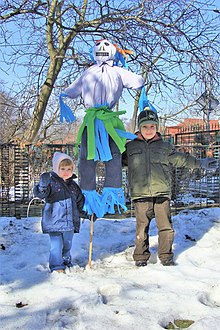| Morana | |
|---|---|
Goddess of cold, frost, winter, death, and agriculture | |
 Effigy of Morana (Death Goddess). Czech Republic. | |
| Equivalents | |
| Christian equivalent | Our Lady of the Herbs |
| Greek equivalent | Hecate, Atropos, Demeter |
| Roman equivalent | Morta, Ceres |
| Latvian equivalent | Māra |
| Lithuanian equivalent | Morė |


Morana (in Czech, Slovene and Serbo-Croatian), Morena (in Slovak and Macedonian), Mora (in Bulgarian), Mara (in Ukrainian), Morė (in Lithuanian), Marena (in Russian), or Marzanna (in Polish) is a pagan Slavic goddess associated with seasonal rites based on the idea of death and rebirth of nature. She is an ancient goddess associated with winter's death, rebirth and dreams. In ancient Slavic rites, the death of the Goddess Morana at the end of winter becomes the rebirth of Spring of the Goddess Kostroma (Russian), Lada or Vesna representing the coming of Spring.[1]
Some medieval Christian sources such as the Czech 13th century Mater Verborum compare her to the Greek goddess Hecate, associating her with sorcery. 15th century Polish chronicler Jan Długosz likened her in his Annales to Ceres, the Roman goddess of agriculture (together with another Slavic goddess Dziewanna).
In modern times the rituals associated with Marzanna have lost their sacred character and are a pastime – an occasion to have fun and celebrate the beginning of spring. The tradition is usually celebrated around the spring equinox (March 21)[citation needed]. Usually schoolchildren and young people participate in the celebrations alongside local folklore groups and other residents. A procession consisting of men, women and children carries handmade Morana (and often also Marzaniok dolls, the male counterpart to Morana) to the nearest river, lake or pond. The participants sing traditional songs and throw effigies of Morana into the water. Sometimes the effigies are first set on fire, or their clothes are torn. On the journey back to the village the focus falls on the copses, adorned with ribbons and blown egg shells. The procession, still singing, returns to the village. In some locations (e.g. in Brynica – a district of Miasteczko Śląskie), the beginning of spring is then celebrated with a feast.
- ^ Szyjewski, Andrzej (2003). Religia Słowian [Religion of the Slavs] (in Polish). Kraków: Wydawn. WAM. ISBN 8373182055.